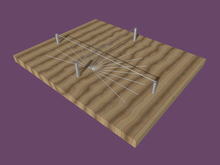Bifilar sundial

sun / shadow rays marked
(red: day orbit ( summer solstice ), green: hour line (II o'clock))
The bifilar sundial is a type of sundial that was introduced by math teacher Hugo Michnik in 1922. Two intersecting but not intersecting rods or threads serve as shadow throwers - this is why Michnik called this sundial the bifilar sundial. The time is shown on the dial from the intersection of the two shadows of the line. The projection used here is a generalization of the gnomonic projection underlying sundials with Nodus as a shadow object .
Michnik showed that the bifilar principle is suitable for all display options known from Nodus sundials, i.e.
- for the hour angle of the sun as the time,
- for the declination of the sun, because the day arc can be seen as a function of the season,
- for displaying sidereal time , Babylonian and Italian hours
- as well as for displaying temporal hours .
The most commonly built bifilar sundial is the one with homogeneous hour lines (see illustrations). The shifting of the shadow formation from the point (Nodus) to two threads that can be positioned in various ways relative to one another and to the dial allows an arrangement to be found in which the hour lines follow one another in 15 ° angular steps like the great circles with the sun in the sky . Both threads are parallel to the dial. The closer thread (distance ) has east-west alignment, the more distant one (distance ) forms a right angle with the closer one in the orthogonal parallel projection on the dial . The condition already given by Michnik for homogeneous hour lines is:
- .
Here is the geographical latitude of the location of the sundial.
The variety of how the threads can be arranged is an incentive for a large number of experimental bifilar sundials. As a rule, a certain individual display is possible, but not an easy-to-make sundial that is universal like the bifilar sundial with homogeneous hour lines. The latter has the disadvantage of a greater east-west extension than the sundial with nodus. Because of the earlier blurring of the shadow cross, the display in the morning and in the evening is more limited than with the Nodus.
Individual evidence
-
↑ H. Michnik: Theory of a bifilar sundial. In: Astronomical News. 217, No. 5190, 1922, p. 81 ( fakesimile );
by the same author: investigation of the temporary hour lines of ancient sundials . In: Annual reports of the Royal High School in Beuthen, 1913–14, supplement, Teubner, Leipzig 1914 ( digitized version ) - ↑ Karl Schwarzinger: Orologio bifilar - Bifilar sundial . In: Sundials Fig. 38/1 November 7, 2001.
- ^ Siegfried Wetzel: Sundial and mathematics . (Section: 4. The Gnomonic and Bifilar Sundials ).




